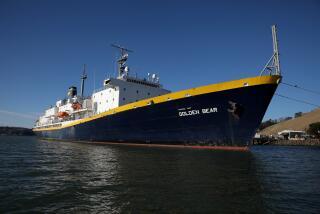Maritime School Anchors Its Teaching in Practicality
- Share via
Her eyes glow even when describing her most menial shipboard tasks, but it is the isolation that calls Makahla Moss to the sea.
A senior at the California Maritime Academy, Moss is able to indulge her enthusiasm for the water during the three international cruises required of every student--a sort of driver’s training for aspiring sailors.
After their first and third years, the students travel on the school’s training ship, a former Navy vessel dubbed the Golden Bear, which this year steamed from the Vallejo school to the South Pacific and back.
During the two-month trip, the 140 students on board the 500-foot vessel do most of the work, with staff members on hand to advise.
As the boat cruised from Long Beach to Catalina on a recent morning, Moss and a handful of others loaded the ship’s mooring lines hand-over-hand into the ship’s belly while some monitored the gauges in the engine room’s steamy heat. On the bridge, the ship’s control center, three students kept watch as one steered and two pored over navigation charts of the San Pedro Channel.
Even as she labored, Moss frequently turned her sunburned face to the water, grinning spontaneously as the sun rose over the calm expanse of turquoise ocean.
“It’s so beautiful,” said Moss, 23, of Benicia. “You just see out to the horizon with nothing in front of you but endless seclusion.”
Moss’ passion for the sea is echoed by most of the students on track for one of the school’s five bachelor’s degrees, including marine engineering and marine transportation. Many of the students’ tasks are below deck: toilet repair, for example, or cafeteria cleanup and engine room duty.
The California Maritime Academy, part of the California State University system, is one of the country’s seven college degree-granting marine schools and the only one on the West Coast. After taking the seamanship classes along with the usual college regimen including English and history, students graduate from the academy with a bachelor’s degree and a ship’s license allowing them to operate almost any vessel afloat.
A license can take twice as long to earn if a student goes straight into the work force, and many students said they didn’t want the commitment of joining the military. The academy says it has a nearly 100% job placement rate for its graduates, whose careers include piloting cruise ships as well as working onshore in marine-related businesses.
Aboard the Golden Bear, a handful of students in blue jumpsuits keep constant watch on the ship’s speed and the dozens of gauges that cover the back wall and a 20-foot center console.
Since the Golden Bear is docked in Vallejo during the school year for training exercises, students become familiar with the machinery well before the ship leaves shore. But it takes seeing the ship in action--whether cruising at full speed or curving slowly around coastlines--to grasp how it all works, sophomore Trevor Rafferty said.
“Before, I knew conceptually what all these things should do, but I didn’t really have any idea what was going on,” said Rafferty, 20, of San Diego. “Now I feel comfortable with doing pretty much anything down here.”
That kind of hands-on experience gives students an invaluable opportunity to physically learn what they read about in the classroom, said ship Capt. Paul Leyda, the university’s marine manager.
“You can do it on a chalkboard, you can even go do practical training on a boat alongside the school, but this is the real thing,” he said.
Although the 12-year-old Golden Bear has some out-of-date equipment, Leyda said training on the ship prepares students for any kind of seagoing experience.
“You have to adapt to a particular vessel, but seamanship is seamanship,” he said.
The staff members on board tend to cluster in the bridge area, watching closely as the students shout commands and providing extra pairs of eyes for those keeping watch. The professionals spot small skiffs and other objects when they’re just shadows on the horizon, patiently pointing them out to the squinting students.
Even those with little or no prior boating experience learn quickly once the ship is under their control, instructor Terry Ruff said.
“I’m just here to answer questions,” he said. “The only time I step in is when something’s going sour.”
More than the ship duties, it’s the leadership opportunities that change the students during their cruise, Ruff said.
“The growth is amazing,” he said. “They come in all fresh-faced and bright-eyed, and by the end, they’re real sailors.”
Sophomore Melany Weaver said commanding others has transformed her from timid to confident.
“At first I would give orders and my voice would squeak, so no one listened,” said Weaver, 19, of Lodi. “Now I feel like a different person.”
Although only about 20 of the students aboard are female, most of the students said that gender doesn’t matter once the work starts.
“Once you show that you can work hard and make an effort, no one notices if you’re a girl,” Weaver said. “When you’re out here everyone is depending on each other. All people notice is if you’re not pulling your weight.”
More than the disproportion in gender, visitors to the ship are often struck by an atmosphere of uniforms and stringent rules that some students call “pseudomilitary.” All students are called cadets, and most only get 1 1/2 days of shore leave when the ship docks.
“This is not a pleasure cruise,” said senior Kevin Freese, wearing a starched white dress uniform with a wry smile that reveals a pierced tongue he admits is very much against regulations.
Still, he added, there is no better preparation for the marine industry than going to a maritime academy. “You’re going to be way ahead of the best in your field,” said Freese, 21, of Benicia.
For sophomore Hank Peretti, a former Merchant Marine from Boston who has worked on boats for 12 years, the degree will advance his career so he will be able to get his officer’s license more quickly.
“I’m getting to skip a lot of steps on the ladder,” said Peretti, 26.
With experience, he handles some of the tasks normally reserved for upperclassmen, such as directing a crane maneuvering a load of alcohol and food onto the boat for an administrator reception.
When they’re not working, the students rest in their rooms, gathering at night on the ship’s rear deck to lie under the stars.
Like Moss, Bob Humann enjoys the water even as he works--although as one of the watch keepers, he’s thinking more about possible whale collisions than the beauty of the sun-dappled waves.
The 19-year-old from Lafayette said cruising on the Golden Bear was what sold him on a career at sea.
“You can decide right here and now if this is what you want for your life,” he said.
More to Read
Sign up for Essential California
The most important California stories and recommendations in your inbox every morning.
You may occasionally receive promotional content from the Los Angeles Times.













